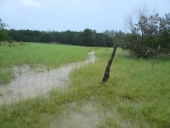I will have to find time to check out the Cell Grazing video. I feel like I am continually fighting my pigs on this subject and the pigs are winning hands down so new approaches are welcome.
John I know exactly what you mean by WWI battlefield, in fact I managed to damage my 2 wheel tractor trying to mow one of these "battlefields" that had been fallow for close to 15 months.
In my experience with Joel Salatin's work I feel like he comes up with reasons/explanations for why he does things rather than approaching it from an idea first. I'm not sure if that explanation makes sense, and I am not attacking him - I will read what he writes as I can learn a lot from him. Maybe I am over analyzing this one picture, but it is hard for me to understand how the paddock on the left is doing anything other than losing soil and organic matter while rapidly drawing in weedy annuals (in many cases my pastures have looked like that after the pigs have gone although we don't have so many large rocks thankfully). The one on the right doesn't look like good grazing to me, I think I can see milk thistles in the foreground -
http://www.nwcb.wa.gov/detail.asp?weed=122 and I am no expert, but I am guessing the brown grass is not good pig forage as mine don't seem to eat grass that isn't young and fairly short.
That said I think he's right about the idea of a sweet spot, it is just a difficult target to hit. From what I have read so far it seems to me like Mark Shepard is on the right track in trying to limit soil disturbance as much as possible with his pigs. If you haven't read "Restoration Agriculture" then I recommend it to you although it is unfortunately light on specifics.



.jpg)

